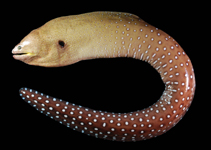| Family: |
Muraenidae (Moray eels), subfamily: Muraeninae |
| Max. size: |
180 cm TL (male/unsexed) |
| Environment: |
reef-associated; marine; depth range 2 - 271 m |
| Distribution: |
Indo-Pacific: Red Sea and Transkei, South Africa (Ref. 3257) to the Hawaiian and Marquesan islands, north to Ryukyu Islands, south to New Caledonia. |
| Diagnosis: |
Dorsal spines (total): 0-0; Dorsal soft rays (total): 0-0; Anal spines: 0-0; Anal soft rays: 0-0. Large individuals; body dark yellow-brown numerous, smaller than pupil-sized spots that become small and numerous anteriorly, but large and widely spaced posteriorly (Ref. 48635). Yellow inside the mouth (Ref. 30404, 48635). This species has a relatively short, blunt snout; the larger specimens lack vomerine teeth and median intermaxillary teeth; the largest teeth are finely serrate; and jaws not arched, even in large specimens (Ref. 74922). |
| Biology: |
Mainly in oceanic locations (Ref. 48635). Adults are found inhabiting inner and outer reef slopes (Ref. 30404). Benthic (Ref. 58302). Mucus is toxic (Ref. 1602). |
| IUCN Red List Status: |
Least Concern (LC); Date assessed: 18 August 2011 Ref. (130435)
|
| Threat to humans: |
poisonous to eat |
Source and more info: www.fishbase.org. For personal, classroom, and other internal use only. Not for publication.
